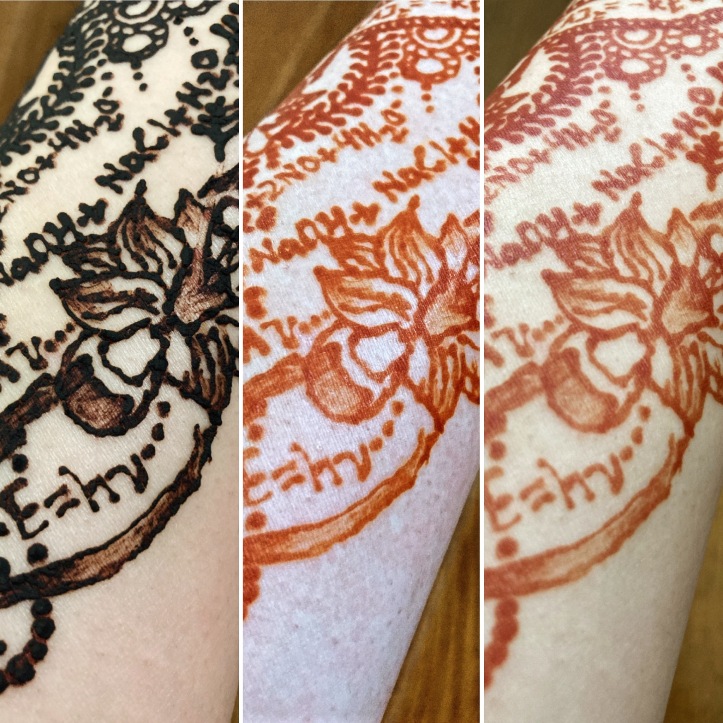By Safia Jilani
When you say art, some people might think of paint with canvases, graphite and paper, or engravings in pottery. I believe art can be all those things and more, but for me, at least twice a year, it can be henna on my hands. One of those times happens to be for an Islamic holiday celebrated today, Eid Al-Fitr. In some traditions, henna is often applied on religious holidays, such as Eid Al-Fitr and Eid Al-Adha, as a way to symbolize beauty, joy, and celebration.
As a South Asian American Muslim, I apply henna (Arabic: حِنَّاء or Urdu: مہندی) as a part of both my religious and cultural backgrounds. I find beauty and joy in chemistry, physics, and mathematics and so I incorporate these themes into my designs and tell stories of science through them. South Asian henna designs often involve a spectrum of symbols that range from simple to complex and symmetrical to asymmetrical patterns. Because of this, there is a wide variety of artistic tools and motifs I can lean on to make science henna designs.
Henna dye comes from the henna plant, Lawsonia inermis, most often from the leaves.1,2 In the plant leaves, the molecule lawsone, or 2-hydroxy-1, 4-naphthoquinone, can be extracted in a paste by grinding the plant leaves in an acidic solvent solution (such as lemon juice). The lemon juice helps extract lawsone from the plant by being acidic and also helps the lawsone oxidize to stain the skin deeper.3 People often prepare henna by mixing it into a paste and putting it into a tube for application on skin – like icing on a cake.

The henna is left on the skin for a few hours or overnight to stain the skin. The lawsone in henna reacts with keratin in skin and that produces a red / orange color.4,5
The lawsone molecule looks like this:

And the reaction of lawsone with keratin in skin looks like this:4,5
C9H5O2C=O + NH2-keratin → C9H5O2C=N-keratin + H2O
In the references I found, there was no explicit figure of this reaction, so here is one possible visual depiction of the reaction:

The carbonyl in lawsone would react with an amine in the keratin, causing the binding of the red-orange pigment from henna into the proteins in the skin.
Here is what this process looked like on my skin this year, from fresh application to right after washing and then one day later:

While the science of how henna stains skin is consistent, how henna is used across different cultures, religions, and traditions is deeply diverse. In my science henna designs, I have told stories of the science I simply love, my research investigations, teaching chemistry in different classes, growth moments in mentoring students, and gratitude of mentors and friends through symbols and designs. In some cases, I also take advantage of my hands being the medium for this art: some designs can be read from left to right, like my hands are two book pages when brought together in a prayer gesture. Or for stories of growth, the science story might start from the base of my hand and end at the fingertips.
For Eid Al-Fitr this year, the story I am sharing in my science henna is in two parts: (1) major growth moments in my thinking and understanding of science from high school to now (a first year postdoc) and (2) major moments of growth in teaching and mentoring from high school to now. The story would be read from the bottom of my forearm (high school related moments of growth) to my fingertips (postdoc related moments of growth). This particular design captures 15 years of growth, learning, and awe.

I am a South Asian American Muslim scientist. And when I work in the lab, my hands put on nitrile gloves, they weigh out chemicals, they polish electrodes, they solder circuits, they push buttons on a keyboard to turn on instruments, and they write their scientific observations in lab notebooks. Those same hands celebrate my culture and faith through actions of service, kindness, and prayer. Science henna is a unique artistic medium in which I can interweave my scientific identity with my South Asian American Muslim woman identities. In my science henna, it is the whole entire expression – the appreciation and joy of science, teaching, mentoring, South Asian culture, and being a Muslim woman.
The chemistry of how henna reacts and stains my skin is consistent every time I apply it, but as each design boldens and fades as my journey of life advances, the stories I tell grow and change on my hands too. Some people see artistic pieces as a static painting or sculpture that stays put in a location. Science henna inherently changes because the stain sheds after a few weeks and that dynamic and ephemeral nature of it makes it even more beautiful to tell science stories on my hands over time.
Whatever your scientific journey or artistic medium, I hope that they also grow and change with you too.
REFERENCES
- Udeani, N.A. Potential of henna leaves as dye and its fastness properties on fabric. World academy of science, engineering and technology Int. J. Chem. Mol. Nucl. Mater. Metall. Eng. 2015, 9, 1433-1440. DOI: 10.5281/zenodo.1110762
- Bhuiyan, M.A.; Islam, A.; Ali, A.; Islam, M.N. Color and chemical constitution of natural dye henna (Lawsonia inermis L) and its application in the coloration of textiles. Journal of Color Production. 2017, 167, 14-22. DOI: 10.1016/j.jclepro.2017.08.142
- Compound Interest blog, The Chemistry of Henna, 2019, https://www.compoundchem.com/2019/08/12/henna/
- Fieser, L. F. & Hathaway, R. Naphthoquinone Antimalarials XIII 2-Hydroxy-3-substituted-aminomethyl Derivatives by the Mannich Reaction. J. Am. Chem. Soc. 1948, 70, 3222-3223. DOI: 10.1021/ja01190a006
- Gallo, F. R. et. al. Henna through the centuries: a quick HPTLC analysis proposal to check henna identity. Rev. Bras. Farmacogn. 2014, 24, 133-140. DOI: 10.1016/j.bjp.2014.03.008
